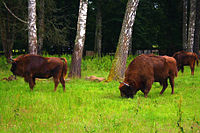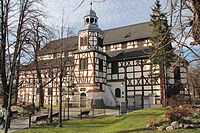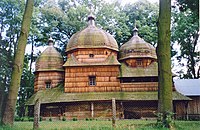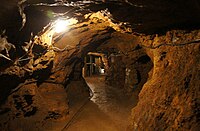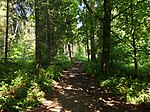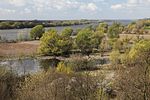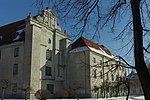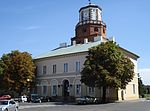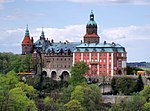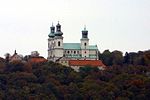World Heritage in Poland
The World Heritage in Poland (as of 2019) includes 16 UNESCO World Heritage sites , including 15 World Cultural Heritage sites and one World Natural Heritage site. Three of these sites are cross-border or transnational . Poland ratified the World Heritage Convention in 1976, and the first two World Heritage sites were added to the World Heritage List in 1978. The last World Heritage site to date was registered in 2019.
World heritage sites
The following table lists the UNESCO World Heritage Sites in Poland in chronological order according to the year of their inclusion in the World Heritage List (K - cultural heritage, N - natural heritage, K / N - mixed, (R) - on the Red List of World Heritage in Danger ).
![]() Map with all coordinates of the World Heritage Sites: OSM
Map with all coordinates of the World Heritage Sites: OSM
| image | designation | year | Type | Ref. | description |
|---|---|---|---|---|---|
|
Historic center of Krakow ( location ) |
1978 | K | 29 | The historic center of Krakow is one of the most important old city centers in present-day Poland. It was the center of political life in Poland from 1038 until King Sigismund III. Wasa moved his court to Warsaw in 1596 . The Wawel Castle and Kazimierz Jewish Quarter are world heritage sites . | |
| Royal Salt Mines Wieliczka and Bochnia | 1978, expanded in 2013 | K | 32 | The salt mines of Wieliczka ( Lage ) and Bochnia ( Lage ) as well as the Salzgrafenschloss ( Lage ) are located in the greater Krakow area. The salt pans produced table salt from the 13th century until 2007, at that time known as one of the world's oldest operating salt mines. For a large part of the time it was part of the » Zupy Krakowskie « company. It is believed to be the 14th-oldest company in the world. | |
| Auschwitz-Birkenau - German National Socialist Concentration and Extermination Camp (1940-1945) | 1979 | K | 31 | Auschwitz was a network of Nazi concentration and extermination camps, set up in Poland, which was occupied by the Third Reich during World War II . It was the largest of the German concentration camps, consisting of Auschwitz I (main camp or base camp location ), Auschwitz II-Birkenau (the extermination camp location ), Auschwitz III-Monowitz , which is also known as Buna-Monowitz (a labor camp) and 45 satellite camps. | |
|
Bialowieza forest area ( location ) |
1979, expanded 1992 and 2014 | N | 33 | The Białowieża Primeval Forest is an ancient forest area on the border between Poland and Belarus . The jungle is 70 km (43 miles) north of Brest, Belarus and 62 km (39 miles) southeast of Białystok (Poland). It is one of the last and largest remaining parts of the vast primeval forest that was once spread across the entire European lowlands. The first recorded law on the protection of the forest dates back to 1538. It was about the document from King Sigismund I the Elder , who introduced the death penalty for poaching bison . The world heritage area extends beyond the boundaries of the national park . | |
|
Warsaw Old Town ( location ) |
1980 | K | 30th | The old town of Warsaw was founded in the 13th century. Originally surrounded by an earth wall, it was fortified with a brick wall before 1339. The city originally grew around the castle of the Dukes of Mazovia , who later became the royal house. The market square ( Rynek Starego Miasta ) was laid out sometime in the late 13th or early 14th century, along the main road that connects the castle with the new town in the north. | |
|
Old town of Zamość ( location ) |
1992 | K | 564 | Jan Zamoyski commissioned the Italian architect Bernardo Morando to design the city, which would be based on the anthropomorphic concept. The main distinguishing features of the old town have been well preserved since its inception. They include the regular large market square areas of 100 × 100 meters with the magnificent town hall and the so-called Armenian houses, as well as the fragments of the original fortress and fortresses, including from the time of the Russian occupation in the 19th century. | |
|
Teutonic Order Castle Malbork (Marienburg) ( location ) |
1992 | K | 847 | The Marienburg was built in Prussia by the Teutonic Order - a German Roman Catholic order of the crusaders - in the form of an order castle . The order called it Marienburg. The city that grew around them was and is also called Marienburg. The castle is a classic example of a medieval fortress. When it was completed in 1406, the palace was the largest brick Gothic castle in the world. Today it is the largest brick building in Europe. | |
|
Old town of Toruń (Torun) ( location ) |
1997 | K | 835 | Toruń has many monuments of architecture from the beginning of the Middle Ages, including 200 military structures. The city is famous for having a medieval floor plan. Many Gothic buildings are made of brick. These include monumental churches, the town hall and many town houses, which are almost completely preserved. Due to frequent flooding, the city was relocated to its current location in the old town in 1236. In 1264 the nearby new town was founded. In 1280 the city (or as it was then, both cities) joined the mercantile Hanseatic League and thus became an important medieval trading center. | |
|
Zebrzydowska Calvary ( location ) |
1999 | K | 905 | The city is named after the religious complex (Calvary) founded by the governor of Cracow, Mikołaj Zebrzydowski , on December 1, 1602. The complex is known as Kalwaria Zebrzydowska Park. The city of Zebrzydów was founded in 1617 to accommodate the growing number of pilgrims visiting the religious complex.
|
|
| Peace churches in Jawor ( Jauer ) and Świdnica ( Schweidnitz ) | 2001 | K | 1054 | The peace churches in Jawor ( Lage ) and Świdnica ( Lage ) in Silesia were named after the Peace of Westphalia of 1648, which allowed Lutherans to build three Protestant churches out of wood, clay and straw in the Roman Catholic part of Silesia. The churches were built outside the city walls without the help of stones or nails and have neither steeples nor church bells. The construction time was limited to one year. In spite of these severe restrictions in construction, imposing structures were built.
|
|
| Wooden churches in the south of Lesser Poland | 2003 | K | 1053 | The late Middle Ages wooden church style of the region, dating back to the late 16th century, began with Gothic ornamentation and polychrome details. However, since it was wooden building structures, the structure, general shape and feel were completely different from the Gothic architecture of the Polish Gothic (in stone or brick).
The six churches mentioned on the list include: The Parish Church of Archangel Michael in Binarowa (Lage) , the Parish Church of All Saints in Blizne (Lage) , the Parish Church of Archangel Michael in Dębno (Lage) , the Affiliate Church of the Assumption in Haczów (Lage ) , the cemetery church of St. Leonhard in Lipnica Murowana (Lage) and the subsidiary church of St. Philip and James in Sękowa (Lage) .
|
|
|
Park Muzakowski (Muskauer Park) ( location ) |
2004 | K | 1127 | Muskauer Park is the largest and one of the most famous English gardens in Germany and Poland. In the historic Upper Lusatia, the park in Poland covers an area of 3.5 square kilometers (1.35 square miles) and 2.1 km² (0.81 mile² / sq mile) in Germany. UNESCO has added the park to the list of world cultural heritage as an exemplary example of cross-border cultural cooperation between Poland and Germany. Cultural heritage together with Germany .
|
|
|
Centennial Hall in Wroclaw ( location ) |
2006 | K | 1165 | The Jahrhunderthalle (formerly Volkshalle) is a historic building in Wroclaw . It was built according to the plans of the architect Max Berg between 1911 and 1913 when the city was part of the German Empire. The Frankfurt Festhalle was the model for the dome . As one of the first landmarks of reinforced concrete architecture, it was listed as a UNESCO World Heritage Site.
|
|
| Wooden churches of the Carpathian region in Poland and Ukraine | 2013 | K | 1424 | The wooden churches in the Northern Carpathians were built between the 16th and 19th centuries. These are Greek Orthodox or Eastern Catholic church buildings, most of which were used by the local Ukrainian population. The eight churches in Poland include the Church of Saint Paraskewa in Radruż (Lage) , the Church of the Nativity of the Blessed Virgin Mary in Chotyniec (Lage) , the Church of Archangel Michael in Smolnik (Lage) , the Church of Archangel Michael in Turzańsk ( Lage) , the St. James Church in Powroźnik (Lage) , the Church of the Care of the Blessed Virgin Mary in Owczary (Lage) , the Church of Saint Parasekewa in Kwiatoń (Lage) and the Church of Archangel Michael in Brunary (Lage) . | |
|
Tarnowskie Góry lead-silver-zinc mine and its underground water management system ( location ) |
2017 | K | 1539 | Tarnowskie Góry was an important location for silver, lead and zinc mining. The dewatering from the 15th to 16th centuries has a total length of 200 km. | |
|
Montan region for the prehistoric extraction of banded flint ( location ) |
2019 | K | 1599 | The world heritage site consists of four mining sites from the Neolithic and the Bronze Age, in which striped flint was mined and processed. The flint was mainly used as a blade for axes. The remains of workshops, shafts and pits are preserved in situ. Thus, this site provides a comprehensive understanding of life at the time and the importance of the flint for early human development. |
Tentative list
The sites that are intended for nomination for inclusion in the World Heritage List are entered in the tentative list .
Current World Heritage candidates
Currently (2019) six sites are entered in the tentative list of Poland. The following table lists the sites in chronological order according to the year of their inclusion in the tentative list.
![]() Map with all coordinates of the World Heritage candidates: OSM
Map with all coordinates of the World Heritage candidates: OSM
| image | designation | year | Type | Ref. | description |
|---|---|---|---|---|---|
|
Gdańsk - the city of memory and freedom ( location ) |
2005 | K | 530 | A previous application was rejected by ICOMOS in 1998, another attempt was initially withdrawn by Poland in 2007. | |
|
Augustów Canal (Kanał Augustowski) ( location ) |
2006 | K | 2101 | The application was initially withdrawn in 2010, and a new decision is expected in 2019.
|
|
|
Dunajec gorge in the Pienines ( location ) |
2006 | N | 2102 | The Slovak part is also on the tentative list. | |
|
Primeval beech forests and ancient beech forests of the Carpathian Mountains and other regions of Europe (extension) ( location ) |
2019 | N | 6393 | Expansion of the world heritage site of primeval beech forests in the Carpathian Mountains and old beech forests in Germany to include a protected area in the Bieszczady National Park .
Poland had nominated the expansion for 2017, but withdrew the nomination before the meeting of the World Heritage Committee. This nomination has existed since 2015 (Ref. 6018 ). |
|
|
Modernist center of Gdynia - example of building an integrated community ( location ) |
2019 | K | 6431 | Among the modernist buildings are, among others: a court, the town hall, churches, a hospital, a school, a post office, hotels, the train station, banks, office buildings and the market hall. | |
|
Paper mill in Duszniki-Zdrój ( location ) |
2019 | K | 6439 | A transnational application with the Czech Republic, Germany and France is planned |
Former World Heritage candidates
These sites were previously on the tentative list, but were withdrawn or rejected by UNESCO. Sites that are included in other entries on the tentative list or that are part of world heritage sites are not taken into account here.
![]() Map with all coordinates of former World Heritage candidates: OSM
Map with all coordinates of former World Heritage candidates: OSM
| image | designation | year | Type | Ref. | description |
|---|---|---|---|---|---|
|
Jasna Góra with the Pauline Monastery ( location ) |
1991 | K | 563 | The monastery houses the Black Madonna. The motion was postponed in 1991 to review artistic merit. | |
| Cedynia-Chojna-Moryń region ( location ) |
1993-1996 | K | The region around the cities of Cedynia , Chojna and Moryń is located in western Poland in the West Pomeranian Voivodeship , east of the German border, at the level of the Lower Oder Valley National Park. | ||
|
Żuławy Wiślane - The Vistula Delta ( location ) |
1993-1996 | K / N | Żuławy Wiślane refers to the area around the Vistula River Delta . | ||
| The Lower Vistula Valley ( location ) |
1993-1996 | K / N | The valley of the lower reaches of the Vistula | ||
|
The Łowicki region ( location ) |
1993-1996 | K | Region in the Łódź Voivodeship | ||
| Sejny and Wigry region ( location ) |
1993-1996 | K / N | Region around the town of Sejny and Lake Wigry in the Podlaskie Voivodeship in north-eastern Poland | ||
|
The Wieluń region ( location ) |
1993-1996 | K | Region in the Łódź Voivodeship | ||
| Historical district of Książ ( location ) |
1993-1996 | K | Książ is a district of the town of Wałbrzych with the Fürstenstein Castle | ||
|
Góra Świętej Anny and surroundings ( location ) |
1993-1996 | K | Region around the town of Sankt Annaberg (Góra Świętej Anny) in the Opole Voivodeship (Opole) | ||
|
Tyniec, Bielany and Salwator ( location ) |
1993-1996 | K | Monasteries and churches in three districts in the western districts of Krakow | ||
| The Kazimierz Dolny-Janowiec-Nałęczów region ( location ) |
1993-1996 | K? | Region around the cities of Kazimierz Dolny , Janowiec and Nałęczów in the Powiat Puławski of the Lublin Voivodeship | ||
| Wooden churches in southern Lesser Poland | 2000-2003 | K | Only some of the wooden churches nominated in 2003 were included in the World Heritage List (Ref. 1053 ). The parish church of St. Peter and Paul in Lachowice (Lage) , the parish church of St. John in Orawka (Lage) and the parish church of Archangel Michael in Szalowa (Lage) were rejected . | ||
|
Cathedral of St. John the Baptist ( location ) |
2002-2006 | K | Cathedral church on Ostrów Tumski , the cathedral island of Wroclaw | ||
|
Krzeszów - Cistercian Monastery ( location ) |
2002-2006 | K | former Cistercian abbey in the district of Krzeszów of the rural community Kamienna Góra in the powiat Kamiennogórski in the Lower Silesian Voivodeship . | ||
| Prądnik Valley in Ojców National Park ( location ) |
2002-2006 | K / N | Valley of the Prądnik River in the Ojców National Park in the Lesser Poland Voivodeship
The area was on the tentative list as early as 1993–1996 under the name " Ojców - Pieskowa Skała Region " |
Web links
- Poland on the UNESCO World Heritage Center website.
Individual evidence
- ↑ Poland. In: whc.unesco.org. UNESCO World Heritage Center, accessed July 19, 2017 .
- ^ Tentative list of Poland. In: whc.unesco.org. UNESCO World Heritage Center, accessed July 19, 2017 .
- ^ Nominations to the World Heritage List. (PDF) World Heritage Committee, p. 3 , accessed on July 20, 2017 (English).
- ^ Former Tentative Sites of Poland. In: World Heritage Site. Retrieved July 19, 2017 .





